Analyzing Business Models in Dynamic Environments and Innovation
VerifiedAdded on 2020/03/04
|7
|2118
|42
Essay
AI Summary
This essay delves into the concept of business models, exploring their application in various contexts such as e-commerce archetypes, activity systems, and cost-revenue architecture. It addresses the challenges of static and dynamic problems, design and redesign issues, and the importance of flexibility in response to changing business environments. The essay examines the impact of dynamism on business models, illustrated by the example of Coles and its technological advancements. It also discusses decision-making processes for managers dealing with changes and the significance of adaptability and proactive strategies. The study covers both macro and micro environmental factors, the role of business models in cost management and revenue generation, and the seven business archetypes. It also provides the importance of business model in facing challenges and how to solve the issues. The essay concludes by emphasizing the critical role of business models in planning growth and adapting to changes, highlighting the need for managers to anticipate future trends and make informed decisions by involving employees and customers.
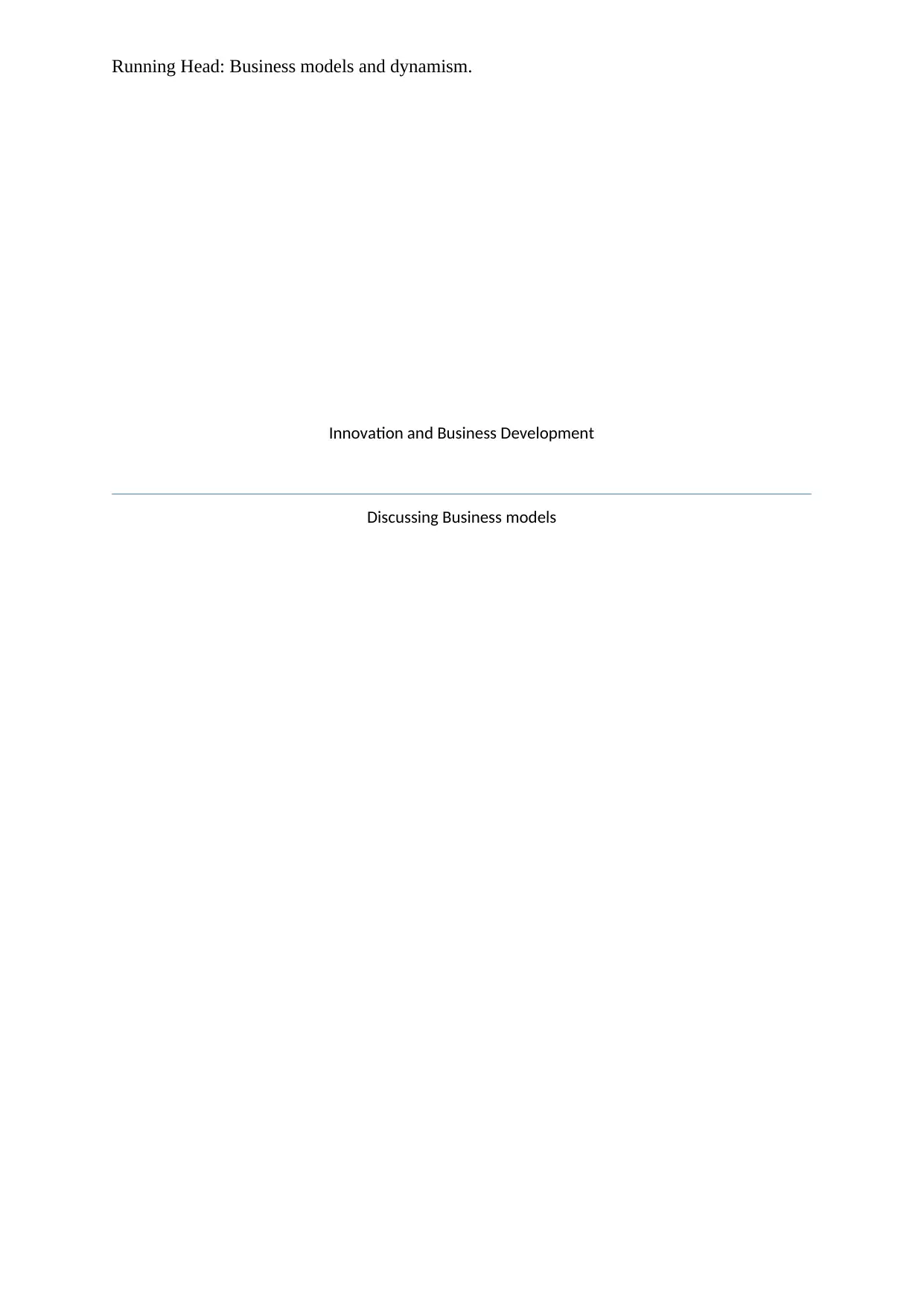
Running Head: Business models and dynamism.
Innovation and Business Development
Discussing Business models
Innovation and Business Development
Discussing Business models
Paraphrase This Document
Need a fresh take? Get an instant paraphrase of this document with our AI Paraphraser
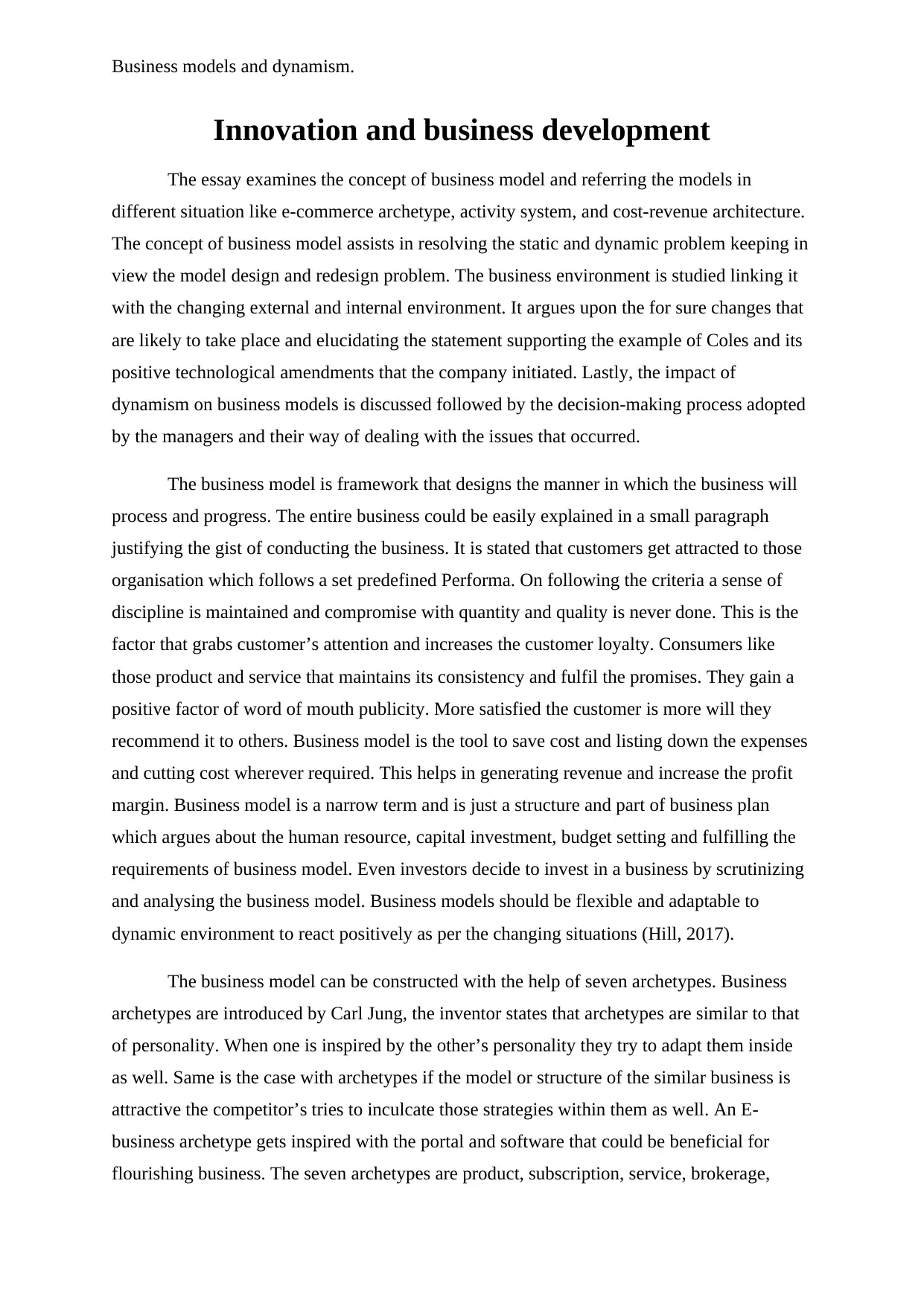
Business models and dynamism.
Innovation and business development
The essay examines the concept of business model and referring the models in
different situation like e-commerce archetype, activity system, and cost-revenue architecture.
The concept of business model assists in resolving the static and dynamic problem keeping in
view the model design and redesign problem. The business environment is studied linking it
with the changing external and internal environment. It argues upon the for sure changes that
are likely to take place and elucidating the statement supporting the example of Coles and its
positive technological amendments that the company initiated. Lastly, the impact of
dynamism on business models is discussed followed by the decision-making process adopted
by the managers and their way of dealing with the issues that occurred.
The business model is framework that designs the manner in which the business will
process and progress. The entire business could be easily explained in a small paragraph
justifying the gist of conducting the business. It is stated that customers get attracted to those
organisation which follows a set predefined Performa. On following the criteria a sense of
discipline is maintained and compromise with quantity and quality is never done. This is the
factor that grabs customer’s attention and increases the customer loyalty. Consumers like
those product and service that maintains its consistency and fulfil the promises. They gain a
positive factor of word of mouth publicity. More satisfied the customer is more will they
recommend it to others. Business model is the tool to save cost and listing down the expenses
and cutting cost wherever required. This helps in generating revenue and increase the profit
margin. Business model is a narrow term and is just a structure and part of business plan
which argues about the human resource, capital investment, budget setting and fulfilling the
requirements of business model. Even investors decide to invest in a business by scrutinizing
and analysing the business model. Business models should be flexible and adaptable to
dynamic environment to react positively as per the changing situations (Hill, 2017).
The business model can be constructed with the help of seven archetypes. Business
archetypes are introduced by Carl Jung, the inventor states that archetypes are similar to that
of personality. When one is inspired by the other’s personality they try to adapt them inside
as well. Same is the case with archetypes if the model or structure of the similar business is
attractive the competitor’s tries to inculcate those strategies within them as well. An E-
business archetype gets inspired with the portal and software that could be beneficial for
flourishing business. The seven archetypes are product, subscription, service, brokerage,
Innovation and business development
The essay examines the concept of business model and referring the models in
different situation like e-commerce archetype, activity system, and cost-revenue architecture.
The concept of business model assists in resolving the static and dynamic problem keeping in
view the model design and redesign problem. The business environment is studied linking it
with the changing external and internal environment. It argues upon the for sure changes that
are likely to take place and elucidating the statement supporting the example of Coles and its
positive technological amendments that the company initiated. Lastly, the impact of
dynamism on business models is discussed followed by the decision-making process adopted
by the managers and their way of dealing with the issues that occurred.
The business model is framework that designs the manner in which the business will
process and progress. The entire business could be easily explained in a small paragraph
justifying the gist of conducting the business. It is stated that customers get attracted to those
organisation which follows a set predefined Performa. On following the criteria a sense of
discipline is maintained and compromise with quantity and quality is never done. This is the
factor that grabs customer’s attention and increases the customer loyalty. Consumers like
those product and service that maintains its consistency and fulfil the promises. They gain a
positive factor of word of mouth publicity. More satisfied the customer is more will they
recommend it to others. Business model is the tool to save cost and listing down the expenses
and cutting cost wherever required. This helps in generating revenue and increase the profit
margin. Business model is a narrow term and is just a structure and part of business plan
which argues about the human resource, capital investment, budget setting and fulfilling the
requirements of business model. Even investors decide to invest in a business by scrutinizing
and analysing the business model. Business models should be flexible and adaptable to
dynamic environment to react positively as per the changing situations (Hill, 2017).
The business model can be constructed with the help of seven archetypes. Business
archetypes are introduced by Carl Jung, the inventor states that archetypes are similar to that
of personality. When one is inspired by the other’s personality they try to adapt them inside
as well. Same is the case with archetypes if the model or structure of the similar business is
attractive the competitor’s tries to inculcate those strategies within them as well. An E-
business archetype gets inspired with the portal and software that could be beneficial for
flourishing business. The seven archetypes are product, subscription, service, brokerage,
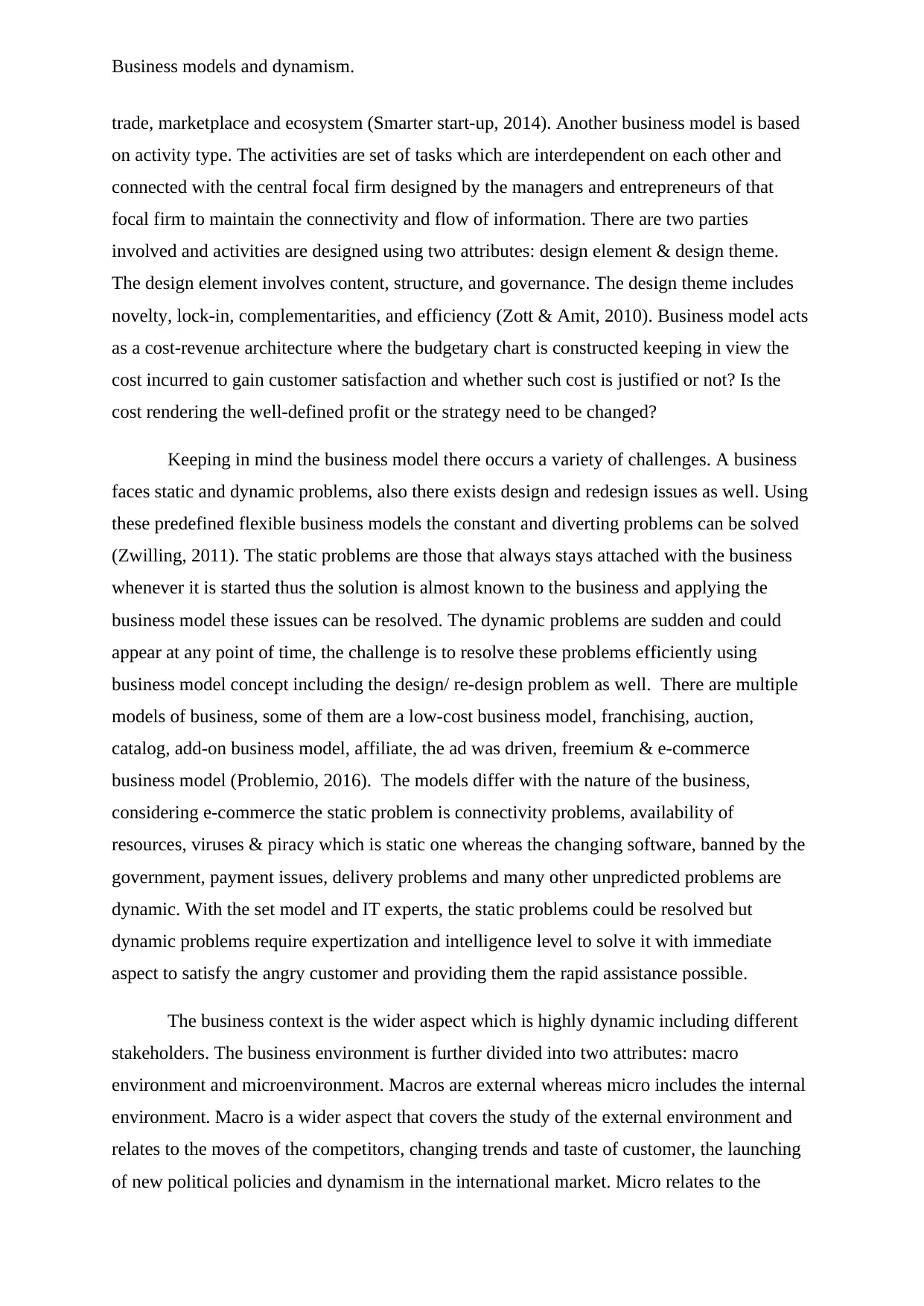
Business models and dynamism.
trade, marketplace and ecosystem (Smarter start-up, 2014). Another business model is based
on activity type. The activities are set of tasks which are interdependent on each other and
connected with the central focal firm designed by the managers and entrepreneurs of that
focal firm to maintain the connectivity and flow of information. There are two parties
involved and activities are designed using two attributes: design element & design theme.
The design element involves content, structure, and governance. The design theme includes
novelty, lock-in, complementarities, and efficiency (Zott & Amit, 2010). Business model acts
as a cost-revenue architecture where the budgetary chart is constructed keeping in view the
cost incurred to gain customer satisfaction and whether such cost is justified or not? Is the
cost rendering the well-defined profit or the strategy need to be changed?
Keeping in mind the business model there occurs a variety of challenges. A business
faces static and dynamic problems, also there exists design and redesign issues as well. Using
these predefined flexible business models the constant and diverting problems can be solved
(Zwilling, 2011). The static problems are those that always stays attached with the business
whenever it is started thus the solution is almost known to the business and applying the
business model these issues can be resolved. The dynamic problems are sudden and could
appear at any point of time, the challenge is to resolve these problems efficiently using
business model concept including the design/ re-design problem as well. There are multiple
models of business, some of them are a low-cost business model, franchising, auction,
catalog, add-on business model, affiliate, the ad was driven, freemium & e-commerce
business model (Problemio, 2016). The models differ with the nature of the business,
considering e-commerce the static problem is connectivity problems, availability of
resources, viruses & piracy which is static one whereas the changing software, banned by the
government, payment issues, delivery problems and many other unpredicted problems are
dynamic. With the set model and IT experts, the static problems could be resolved but
dynamic problems require expertization and intelligence level to solve it with immediate
aspect to satisfy the angry customer and providing them the rapid assistance possible.
The business context is the wider aspect which is highly dynamic including different
stakeholders. The business environment is further divided into two attributes: macro
environment and microenvironment. Macros are external whereas micro includes the internal
environment. Macro is a wider aspect that covers the study of the external environment and
relates to the moves of the competitors, changing trends and taste of customer, the launching
of new political policies and dynamism in the international market. Micro relates to the
trade, marketplace and ecosystem (Smarter start-up, 2014). Another business model is based
on activity type. The activities are set of tasks which are interdependent on each other and
connected with the central focal firm designed by the managers and entrepreneurs of that
focal firm to maintain the connectivity and flow of information. There are two parties
involved and activities are designed using two attributes: design element & design theme.
The design element involves content, structure, and governance. The design theme includes
novelty, lock-in, complementarities, and efficiency (Zott & Amit, 2010). Business model acts
as a cost-revenue architecture where the budgetary chart is constructed keeping in view the
cost incurred to gain customer satisfaction and whether such cost is justified or not? Is the
cost rendering the well-defined profit or the strategy need to be changed?
Keeping in mind the business model there occurs a variety of challenges. A business
faces static and dynamic problems, also there exists design and redesign issues as well. Using
these predefined flexible business models the constant and diverting problems can be solved
(Zwilling, 2011). The static problems are those that always stays attached with the business
whenever it is started thus the solution is almost known to the business and applying the
business model these issues can be resolved. The dynamic problems are sudden and could
appear at any point of time, the challenge is to resolve these problems efficiently using
business model concept including the design/ re-design problem as well. There are multiple
models of business, some of them are a low-cost business model, franchising, auction,
catalog, add-on business model, affiliate, the ad was driven, freemium & e-commerce
business model (Problemio, 2016). The models differ with the nature of the business,
considering e-commerce the static problem is connectivity problems, availability of
resources, viruses & piracy which is static one whereas the changing software, banned by the
government, payment issues, delivery problems and many other unpredicted problems are
dynamic. With the set model and IT experts, the static problems could be resolved but
dynamic problems require expertization and intelligence level to solve it with immediate
aspect to satisfy the angry customer and providing them the rapid assistance possible.
The business context is the wider aspect which is highly dynamic including different
stakeholders. The business environment is further divided into two attributes: macro
environment and microenvironment. Macros are external whereas micro includes the internal
environment. Macro is a wider aspect that covers the study of the external environment and
relates to the moves of the competitors, changing trends and taste of customer, the launching
of new political policies and dynamism in the international market. Micro relates to the
⊘ This is a preview!⊘
Do you want full access?
Subscribe today to unlock all pages.

Trusted by 1+ million students worldwide
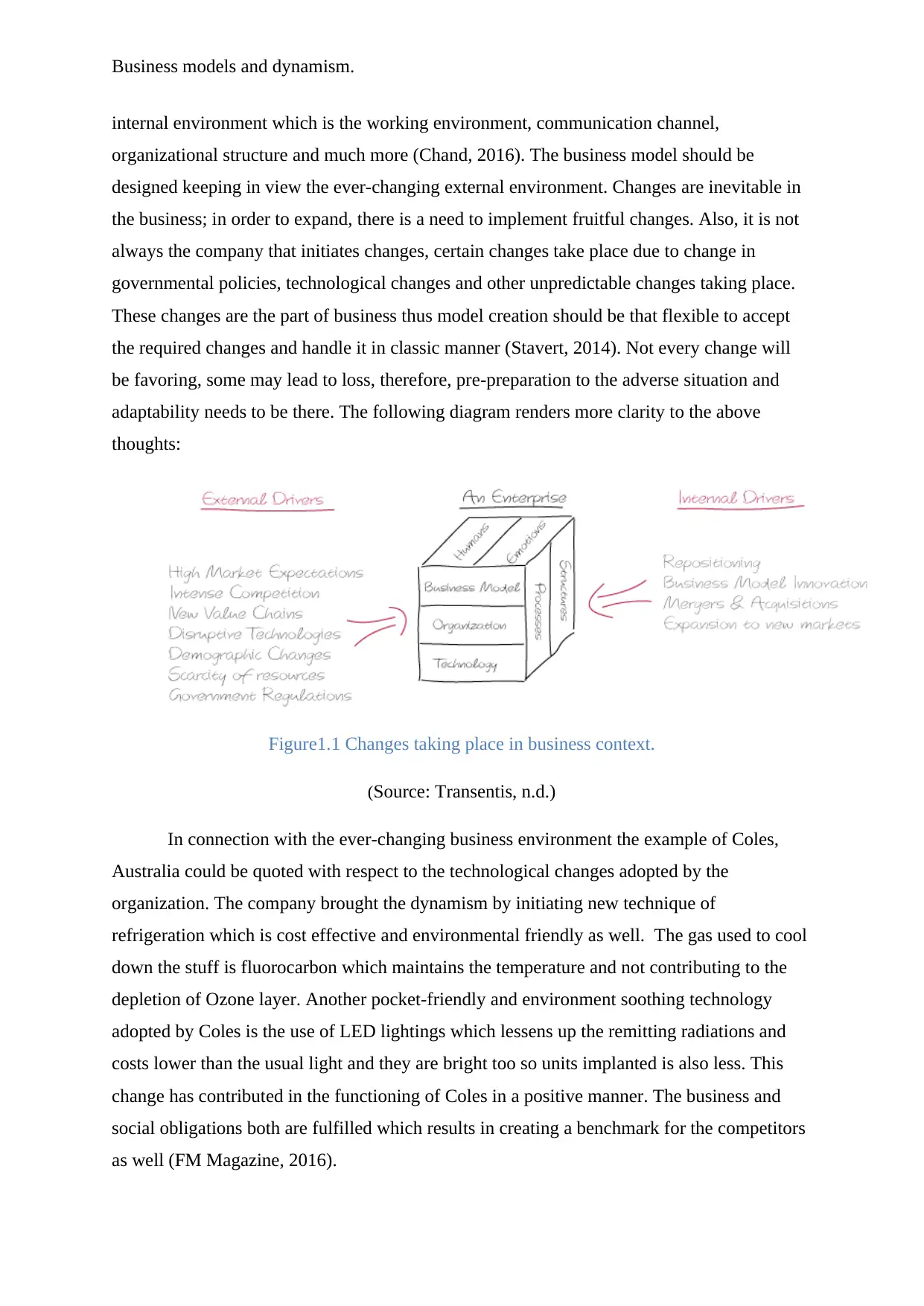
Business models and dynamism.
internal environment which is the working environment, communication channel,
organizational structure and much more (Chand, 2016). The business model should be
designed keeping in view the ever-changing external environment. Changes are inevitable in
the business; in order to expand, there is a need to implement fruitful changes. Also, it is not
always the company that initiates changes, certain changes take place due to change in
governmental policies, technological changes and other unpredictable changes taking place.
These changes are the part of business thus model creation should be that flexible to accept
the required changes and handle it in classic manner (Stavert, 2014). Not every change will
be favoring, some may lead to loss, therefore, pre-preparation to the adverse situation and
adaptability needs to be there. The following diagram renders more clarity to the above
thoughts:
Figure1.1 Changes taking place in business context.
(Source: Transentis, n.d.)
In connection with the ever-changing business environment the example of Coles,
Australia could be quoted with respect to the technological changes adopted by the
organization. The company brought the dynamism by initiating new technique of
refrigeration which is cost effective and environmental friendly as well. The gas used to cool
down the stuff is fluorocarbon which maintains the temperature and not contributing to the
depletion of Ozone layer. Another pocket-friendly and environment soothing technology
adopted by Coles is the use of LED lightings which lessens up the remitting radiations and
costs lower than the usual light and they are bright too so units implanted is also less. This
change has contributed in the functioning of Coles in a positive manner. The business and
social obligations both are fulfilled which results in creating a benchmark for the competitors
as well (FM Magazine, 2016).
internal environment which is the working environment, communication channel,
organizational structure and much more (Chand, 2016). The business model should be
designed keeping in view the ever-changing external environment. Changes are inevitable in
the business; in order to expand, there is a need to implement fruitful changes. Also, it is not
always the company that initiates changes, certain changes take place due to change in
governmental policies, technological changes and other unpredictable changes taking place.
These changes are the part of business thus model creation should be that flexible to accept
the required changes and handle it in classic manner (Stavert, 2014). Not every change will
be favoring, some may lead to loss, therefore, pre-preparation to the adverse situation and
adaptability needs to be there. The following diagram renders more clarity to the above
thoughts:
Figure1.1 Changes taking place in business context.
(Source: Transentis, n.d.)
In connection with the ever-changing business environment the example of Coles,
Australia could be quoted with respect to the technological changes adopted by the
organization. The company brought the dynamism by initiating new technique of
refrigeration which is cost effective and environmental friendly as well. The gas used to cool
down the stuff is fluorocarbon which maintains the temperature and not contributing to the
depletion of Ozone layer. Another pocket-friendly and environment soothing technology
adopted by Coles is the use of LED lightings which lessens up the remitting radiations and
costs lower than the usual light and they are bright too so units implanted is also less. This
change has contributed in the functioning of Coles in a positive manner. The business and
social obligations both are fulfilled which results in creating a benchmark for the competitors
as well (FM Magazine, 2016).
Paraphrase This Document
Need a fresh take? Get an instant paraphrase of this document with our AI Paraphraser
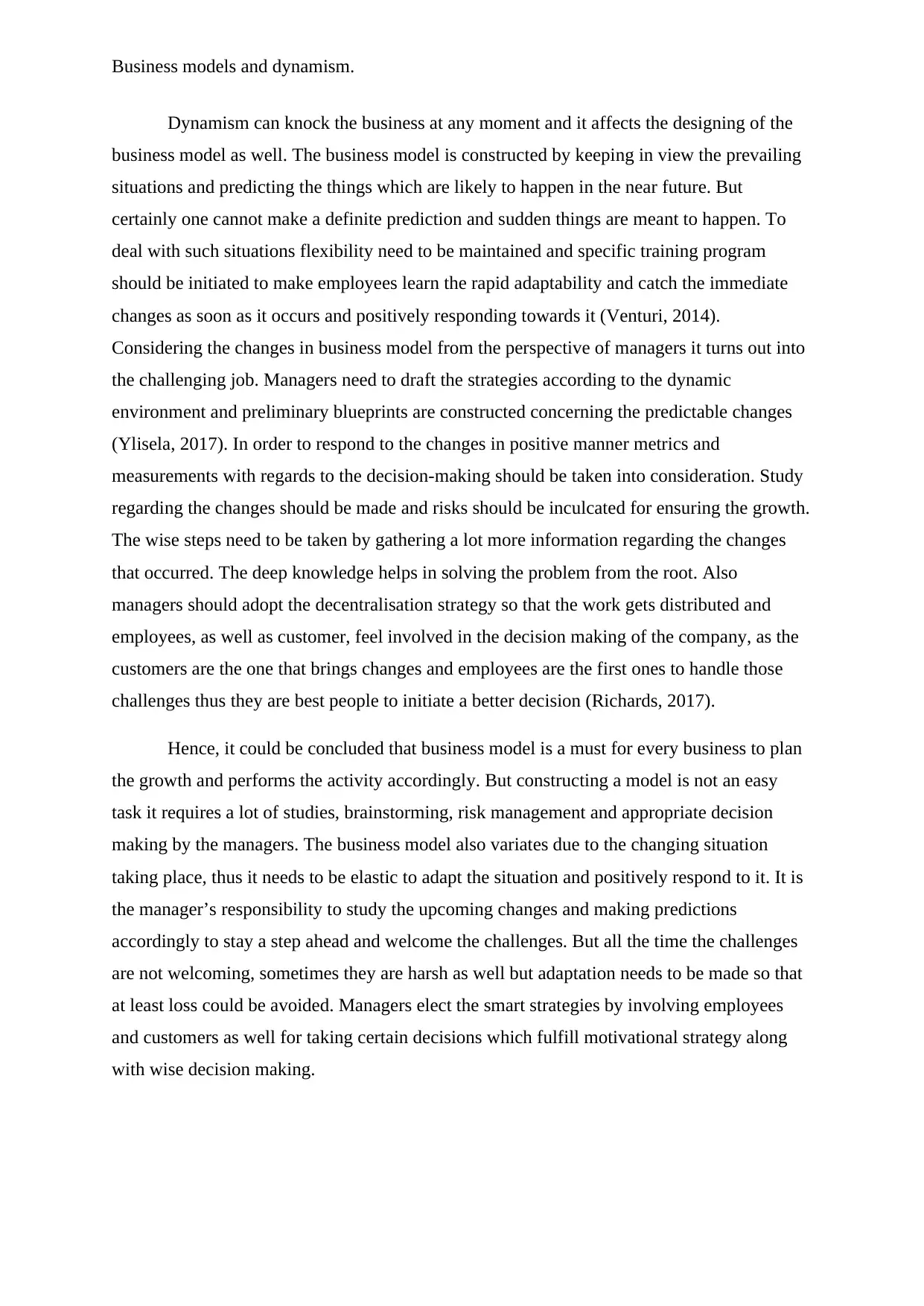
Business models and dynamism.
Dynamism can knock the business at any moment and it affects the designing of the
business model as well. The business model is constructed by keeping in view the prevailing
situations and predicting the things which are likely to happen in the near future. But
certainly one cannot make a definite prediction and sudden things are meant to happen. To
deal with such situations flexibility need to be maintained and specific training program
should be initiated to make employees learn the rapid adaptability and catch the immediate
changes as soon as it occurs and positively responding towards it (Venturi, 2014).
Considering the changes in business model from the perspective of managers it turns out into
the challenging job. Managers need to draft the strategies according to the dynamic
environment and preliminary blueprints are constructed concerning the predictable changes
(Ylisela, 2017). In order to respond to the changes in positive manner metrics and
measurements with regards to the decision-making should be taken into consideration. Study
regarding the changes should be made and risks should be inculcated for ensuring the growth.
The wise steps need to be taken by gathering a lot more information regarding the changes
that occurred. The deep knowledge helps in solving the problem from the root. Also
managers should adopt the decentralisation strategy so that the work gets distributed and
employees, as well as customer, feel involved in the decision making of the company, as the
customers are the one that brings changes and employees are the first ones to handle those
challenges thus they are best people to initiate a better decision (Richards, 2017).
Hence, it could be concluded that business model is a must for every business to plan
the growth and performs the activity accordingly. But constructing a model is not an easy
task it requires a lot of studies, brainstorming, risk management and appropriate decision
making by the managers. The business model also variates due to the changing situation
taking place, thus it needs to be elastic to adapt the situation and positively respond to it. It is
the manager’s responsibility to study the upcoming changes and making predictions
accordingly to stay a step ahead and welcome the challenges. But all the time the challenges
are not welcoming, sometimes they are harsh as well but adaptation needs to be made so that
at least loss could be avoided. Managers elect the smart strategies by involving employees
and customers as well for taking certain decisions which fulfill motivational strategy along
with wise decision making.
Dynamism can knock the business at any moment and it affects the designing of the
business model as well. The business model is constructed by keeping in view the prevailing
situations and predicting the things which are likely to happen in the near future. But
certainly one cannot make a definite prediction and sudden things are meant to happen. To
deal with such situations flexibility need to be maintained and specific training program
should be initiated to make employees learn the rapid adaptability and catch the immediate
changes as soon as it occurs and positively responding towards it (Venturi, 2014).
Considering the changes in business model from the perspective of managers it turns out into
the challenging job. Managers need to draft the strategies according to the dynamic
environment and preliminary blueprints are constructed concerning the predictable changes
(Ylisela, 2017). In order to respond to the changes in positive manner metrics and
measurements with regards to the decision-making should be taken into consideration. Study
regarding the changes should be made and risks should be inculcated for ensuring the growth.
The wise steps need to be taken by gathering a lot more information regarding the changes
that occurred. The deep knowledge helps in solving the problem from the root. Also
managers should adopt the decentralisation strategy so that the work gets distributed and
employees, as well as customer, feel involved in the decision making of the company, as the
customers are the one that brings changes and employees are the first ones to handle those
challenges thus they are best people to initiate a better decision (Richards, 2017).
Hence, it could be concluded that business model is a must for every business to plan
the growth and performs the activity accordingly. But constructing a model is not an easy
task it requires a lot of studies, brainstorming, risk management and appropriate decision
making by the managers. The business model also variates due to the changing situation
taking place, thus it needs to be elastic to adapt the situation and positively respond to it. It is
the manager’s responsibility to study the upcoming changes and making predictions
accordingly to stay a step ahead and welcome the challenges. But all the time the challenges
are not welcoming, sometimes they are harsh as well but adaptation needs to be made so that
at least loss could be avoided. Managers elect the smart strategies by involving employees
and customers as well for taking certain decisions which fulfill motivational strategy along
with wise decision making.
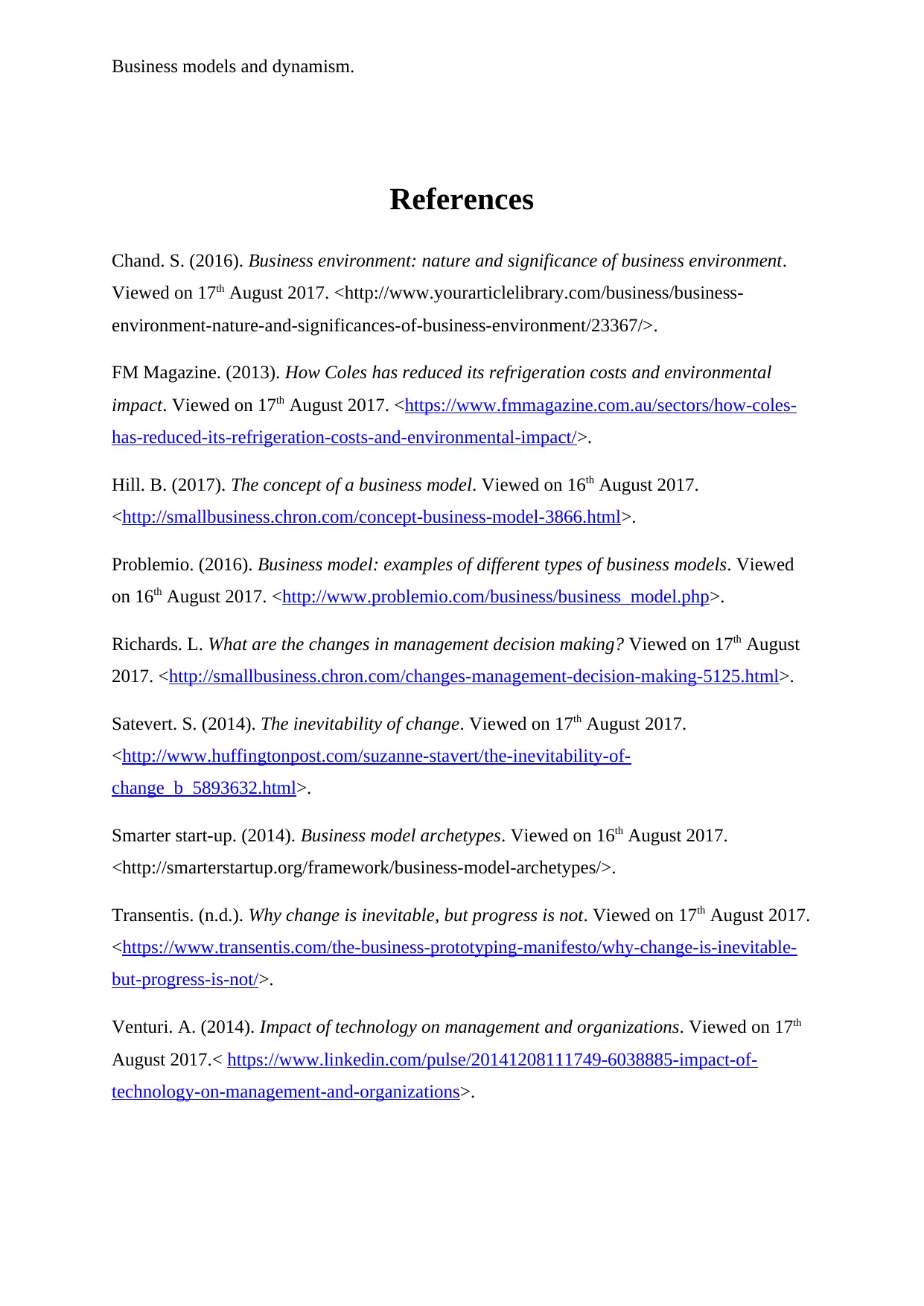
Business models and dynamism.
References
Chand. S. (2016). Business environment: nature and significance of business environment.
Viewed on 17th August 2017. <http://www.yourarticlelibrary.com/business/business-
environment-nature-and-significances-of-business-environment/23367/>.
FM Magazine. (2013). How Coles has reduced its refrigeration costs and environmental
impact. Viewed on 17th August 2017. <https://www.fmmagazine.com.au/sectors/how-coles-
has-reduced-its-refrigeration-costs-and-environmental-impact/>.
Hill. B. (2017). The concept of a business model. Viewed on 16th August 2017.
<http://smallbusiness.chron.com/concept-business-model-3866.html>.
Problemio. (2016). Business model: examples of different types of business models. Viewed
on 16th August 2017. <http://www.problemio.com/business/business_model.php>.
Richards. L. What are the changes in management decision making? Viewed on 17th August
2017. <http://smallbusiness.chron.com/changes-management-decision-making-5125.html>.
Satevert. S. (2014). The inevitability of change. Viewed on 17th August 2017.
<http://www.huffingtonpost.com/suzanne-stavert/the-inevitability-of-
change_b_5893632.html>.
Smarter start-up. (2014). Business model archetypes. Viewed on 16th August 2017.
<http://smarterstartup.org/framework/business-model-archetypes/>.
Transentis. (n.d.). Why change is inevitable, but progress is not. Viewed on 17th August 2017.
<https://www.transentis.com/the-business-prototyping-manifesto/why-change-is-inevitable-
but-progress-is-not/>.
Venturi. A. (2014). Impact of technology on management and organizations. Viewed on 17th
August 2017.< https://www.linkedin.com/pulse/20141208111749-6038885-impact-of-
technology-on-management-and-organizations>.
References
Chand. S. (2016). Business environment: nature and significance of business environment.
Viewed on 17th August 2017. <http://www.yourarticlelibrary.com/business/business-
environment-nature-and-significances-of-business-environment/23367/>.
FM Magazine. (2013). How Coles has reduced its refrigeration costs and environmental
impact. Viewed on 17th August 2017. <https://www.fmmagazine.com.au/sectors/how-coles-
has-reduced-its-refrigeration-costs-and-environmental-impact/>.
Hill. B. (2017). The concept of a business model. Viewed on 16th August 2017.
<http://smallbusiness.chron.com/concept-business-model-3866.html>.
Problemio. (2016). Business model: examples of different types of business models. Viewed
on 16th August 2017. <http://www.problemio.com/business/business_model.php>.
Richards. L. What are the changes in management decision making? Viewed on 17th August
2017. <http://smallbusiness.chron.com/changes-management-decision-making-5125.html>.
Satevert. S. (2014). The inevitability of change. Viewed on 17th August 2017.
<http://www.huffingtonpost.com/suzanne-stavert/the-inevitability-of-
change_b_5893632.html>.
Smarter start-up. (2014). Business model archetypes. Viewed on 16th August 2017.
<http://smarterstartup.org/framework/business-model-archetypes/>.
Transentis. (n.d.). Why change is inevitable, but progress is not. Viewed on 17th August 2017.
<https://www.transentis.com/the-business-prototyping-manifesto/why-change-is-inevitable-
but-progress-is-not/>.
Venturi. A. (2014). Impact of technology on management and organizations. Viewed on 17th
August 2017.< https://www.linkedin.com/pulse/20141208111749-6038885-impact-of-
technology-on-management-and-organizations>.
⊘ This is a preview!⊘
Do you want full access?
Subscribe today to unlock all pages.

Trusted by 1+ million students worldwide
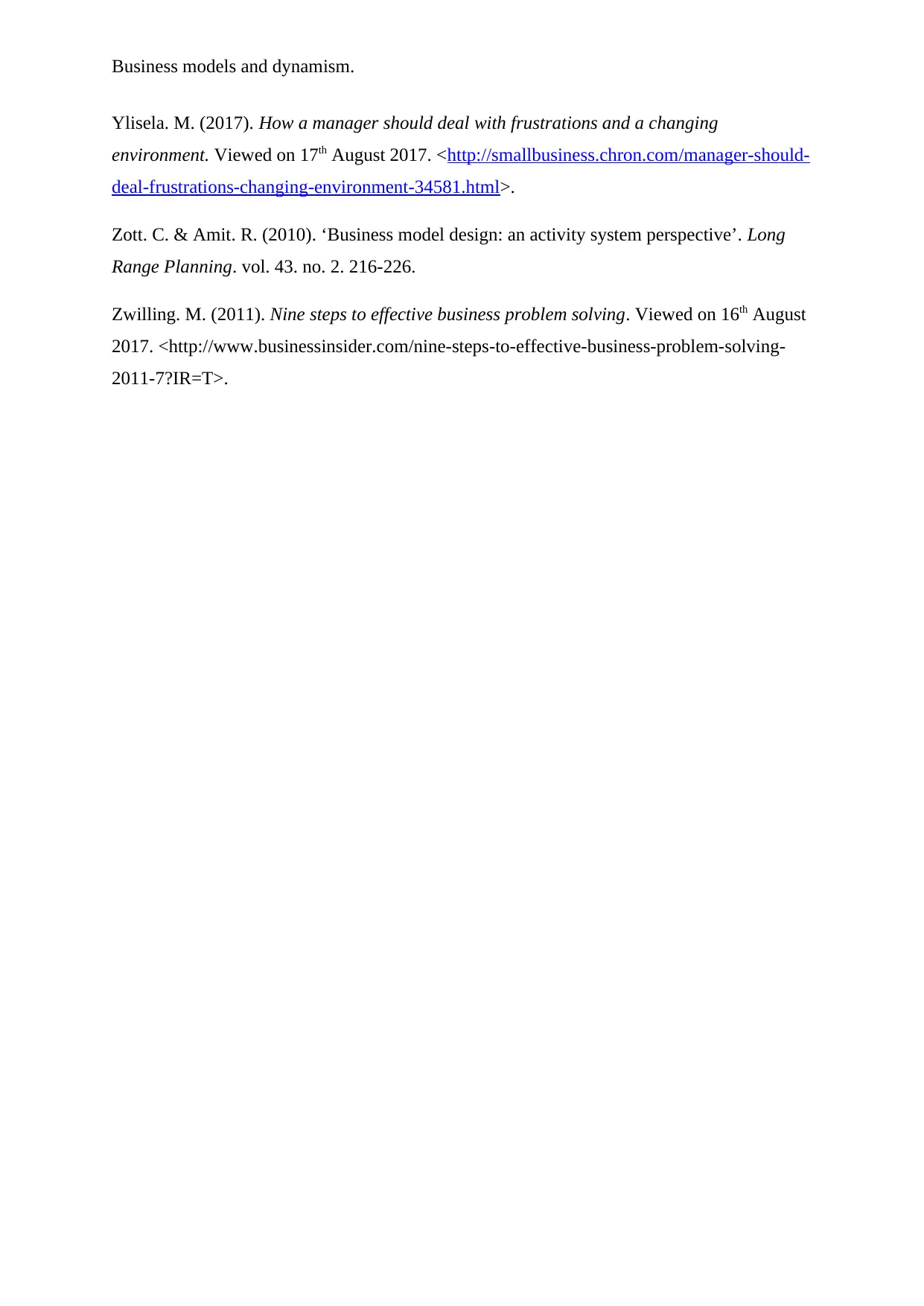
Business models and dynamism.
Ylisela. M. (2017). How a manager should deal with frustrations and a changing
environment. Viewed on 17th August 2017. <http://smallbusiness.chron.com/manager-should-
deal-frustrations-changing-environment-34581.html>.
Zott. C. & Amit. R. (2010). ‘Business model design: an activity system perspective’. Long
Range Planning. vol. 43. no. 2. 216-226.
Zwilling. M. (2011). Nine steps to effective business problem solving. Viewed on 16th August
2017. <http://www.businessinsider.com/nine-steps-to-effective-business-problem-solving-
2011-7?IR=T>.
Ylisela. M. (2017). How a manager should deal with frustrations and a changing
environment. Viewed on 17th August 2017. <http://smallbusiness.chron.com/manager-should-
deal-frustrations-changing-environment-34581.html>.
Zott. C. & Amit. R. (2010). ‘Business model design: an activity system perspective’. Long
Range Planning. vol. 43. no. 2. 216-226.
Zwilling. M. (2011). Nine steps to effective business problem solving. Viewed on 16th August
2017. <http://www.businessinsider.com/nine-steps-to-effective-business-problem-solving-
2011-7?IR=T>.
1 out of 7
Related Documents
Your All-in-One AI-Powered Toolkit for Academic Success.
+13062052269
info@desklib.com
Available 24*7 on WhatsApp / Email
![[object Object]](/_next/static/media/star-bottom.7253800d.svg)
Unlock your academic potential
Copyright © 2020–2025 A2Z Services. All Rights Reserved. Developed and managed by ZUCOL.





